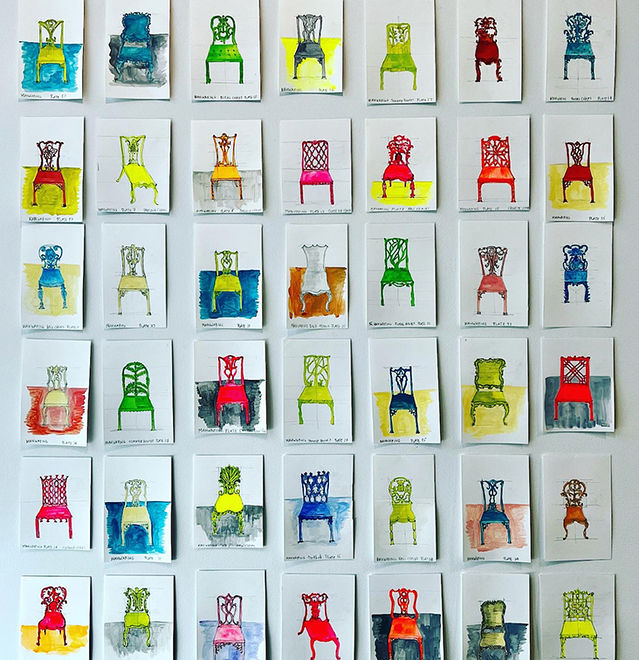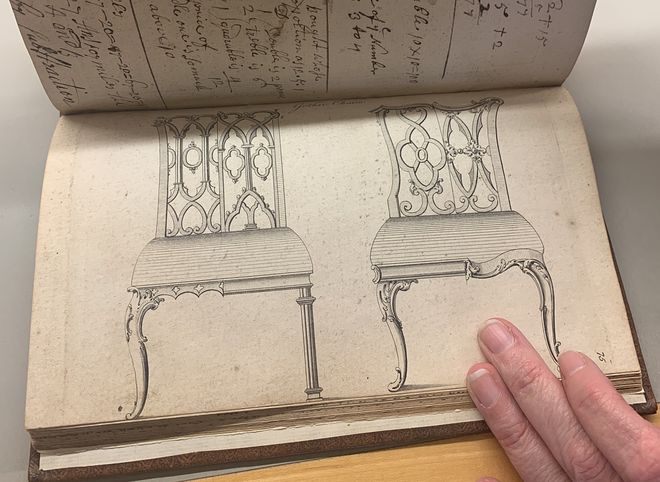
In 2022–23, Bard Graduate Center expanded its Fields of the Future Fellowships by recruiting visual and performance artists whose research could bring diversity to the field of material culture. Annie Coggan, associate professor of interior design at Pratt Institute and a principal in at the multi-scale design firm, Chairs and Buildings Studio, was selected to be the 2023 Lee B. Anderson Fields of the Future Fellow. Her research at BGC focused on Robert Manwaring, an eighteenth-century furniture designer and cabinet maker based in London, and culminated in a small exhibition of the sketches and models of Manwaring’s designs she completed during her fellowship.
Manwaring, a Chippendale contemporary, was particularly well-known for his chairs. He made distinctive sketches that illustrated two possible styles for each of the chair’s design elements, such as the legs and the back, within the drawing of a single chair. Coggan was drawn to the practicality, understanding of materials, and down-to-earth style reflected in Manwaring’s sketches.

Page from Houshold [sic] Furniture In Genteel Taste for the Year 1763. London: Printed for Robt. Sayer …, 1763. Bard Graduate Center Special Collections.
Little could Coggan have known when she began her fellowship that her investigations would take her down a rabbit hole that connected Manwaring, a bootstrapping furniture designer, to James Philips, a sailor eager to advance his knowledge and understanding of the world, through the pages of a rare book housed in the BGC library. Nor could she have anticipated that her efforts to improve her understanding of Manwaring would find a kind of resonance with Philips’s efforts to improve himself.
When Coggan embarked on her research, she found a re-bound edition of Manwaring’s designs in the BGC stacks. It was published in 1763, without a formal title, and it is one of three extant copies of the book. The others are in the archives of the Victoria & Albert Museum and the Metropolitan Museum of Art. While in BGC’s possession, the volume had not had much life off the shelves, perhaps because of the flurry of marginalia that marked up many of its pages. At some point on its journey from publication to its current home in the BGC Library, the book passed through Philips’s hands. In the pages’ margins, and sometimes overlapping with the etchings themselves, he had written about his life as a seaman, taught himself mathematics, and pondered philosophical questions.
Soon after Coggan began leafing through the pages of the book, she became obsessed with deciphering Philips’s handwriting. With the help of Anna Helgeson, former associate director of the library, Coggan found records of Philips in Pembrokeshire parish in Wales. By painstakingly decoding his penmanship, she discovered that he traveled aboard a ship bound for the West Indies in 1777 and 1778, and that was likely when he used the book’s pages to provide the paper he needed for his practice.
Philips seemed not to have any interest in Manwaring’s illustrations, but he used the space between them to diligently transcribe word problems from Thomas Dilworth’s Schoolmaster’s Assistant, often substituting names and objects in the problems for people and situations relevant to his own life. In one instance, he posed the question “What is the devil?” before returning to a word problem on the very same page. Through the book’s materiality, Coggan uncovered a narrative of the life of John Philips, a cerebral fellow with a desire to better his occupational standing through math.
Manwaring and Philips were bound together only within the pages of this book. While Coggan ruminated on their unwitting and asynchronous connection, she sketched and created models of the Manwaring designs and detailed her near daily efforts online using the hashtag #beingmanwaring. This quotidien and endurance aspect of Coggan’s practice intuitively reflected Philips’s daily work of self-improvement and exploration.
